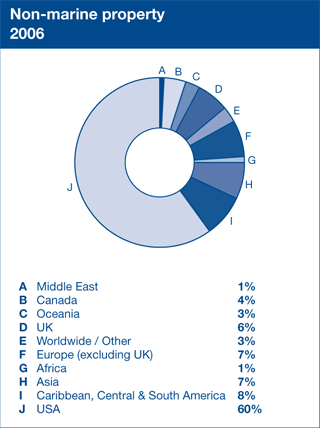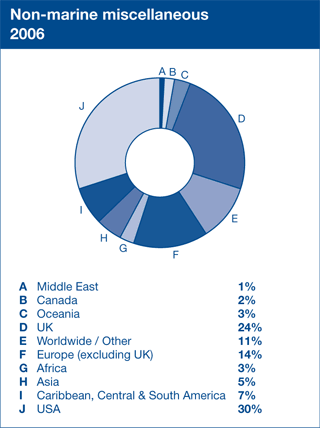Risk Disclosures
1. Non-marine risks
1.i Non-marine property risks

Non-marine property classes
| 2006 gross premium £m |
Current maximum line size £m |
2006 average line size £m |
|
| Catastrophe reinsurance (per programme) |
163 | 50 | 4.0 |
|---|---|---|---|
| Per risk property reinsurance (per programme) |
50 | 20 | 1.7 |
| Proportional reinsurance | 27 | 5 | 0.7 |
| Direct and facultative property | 77 | 20 | 2.8 |
| Binding authorities | 19 | 2 | 0.2 |
Notes:
- Limits are set in US dollars converted to sterling at a rate of £1 = US$1.5 and therefore currency rate of exchange changes may increase or reduce the sterling limits.
- Maximum line size is after business written and ceded by specific proportional treaties to Amlin Bermuda Ltd.
- Premiums are stated net of acquisition costs.
Catastrophe reinsurance protects insurance companies against catastrophic losses such as windstorm or earthquake which may impact more than one risk written by the company. This portfolio is a key aspect of the insurance risk written by the Group. Programmes are placed on a layered or excess of loss basis. Territorial exposures, from a number of programmes, are much higher, but are carefully recorded and analysed through loss simulations or realistic disaster scenarios.
Per risk property reinsurance is also placed on an excess of loss basis but covers loss or damage to a single risk within the reinsureds portfolio. Proportional reinsurance includes taking a pro-rata share of a reinsureds portfolio of business subject to payment of commission and/or profit commission. This is almost all property business and risk exposure is limited to $7.5 million any one risk.
Direct and facultative property insurance is written for the full value of the risk, or on a primary or excess of loss basis, through individual placements, or by way of delegated underwriting facilities given to coverholders (‘Binding authorities’). Under these arrangements the day to day underwriting is delegated to underwriting agents working on our behalf under binding authorities. For these contracts, we are reliant on an agent exercising underwriting judgement on our behalf. We control the underwriting by setting clear authority levels for agents, regularly monitoring performance and periodically carrying out underwriting audits. The maximum value insured is currently limited to $30 million at any one location. Cover is provided to large commercial enterprises with high value locations and/or many locations and also for small commercial property. The perils covered include fire, flood, wind and earthquake damage. Business interruption cover is also provided for loss of earnings sustained due to the perils and properties covered but may also be extended to connected enterprises. Terrorism cover is given on a limited basis particularly where required by local regulation, but nuclear and bio-chemical coverage is excluded in most territories.
The portfolio of property insurance and reinsurance business is written with the aim of achieving territorial diversification. However a severe catastrophe to a major economic zone in Europe, Japan or the USA is likely to result in an overall loss to the property portfolio prior to reinsurance. The Group is exposed to the impact of large catastrophe events such as windstorms, earthquakes or terrorist incidents. Exposure to such events is controlled and measured through loss modelling but the accuracy of this exposure analysis is limited by the quality of data and the effectiveness of the modelling. The Group’s broad risk appetite guidelines are set out on page 18. It is possible that a catastrophe event exceeds the maximum expected event loss. This is particularly the case for the direct property proportion of the loss exposure where models are used to calculate a damage factor representing the amount of damage expected to exposed aggregate insured values. Errors or incorrect assumptions in the damage factor calculation can result in an incurred catastrophe event higher than predicted due to unforeseen circumstances. As explained below the syndicate buys a reinsurance programme to protect the Group against severe catastrophe. However the price and availability of such cover is variable and the amount of loss retained by the Group may therefore also increase or reduce. The Group will alter inwards exposures to take account of the change in reinsurance availability in order to remain within the risk appetite. However, there may be some period of delay before this can be achieved.
The property portfolio is also exposed to an above average frequency of individual fire, explosion or weather related claims. The premium charged for the coverage given may not be sufficient to cover all claims made in any year, particularly in a year in which there is an abnormal frequency of claims.
1.ii US casualty risk
The US casualty portfolio of business is protection given to cover individuals or companies to indemnify against legal liability arising from their activities and actions or for incidents occurring on their property. The account is currently written on an insurance and reinsurance basis to a maximum liability of $4 million on any one claim but average lines are $0.6 million on any one claim.
The portfolio is made up of specialist general casualty, professional indemnity, medical malpractice and errors and omissions cover. The syndicate is a recognised market leader for nursing home cover and contractors’ general liability. Small amounts of directors’ and officers’ liability and auto liability are also written. The class is written on a claims notified basis (responding to all claims made during a defined period) except for £1 million of the contractors’ general liability business which is written on a losses occurring basis (the policy responds to losses which occur during the period even if reported after the policy has expired).
Claims from this class emanate from professional error, negligence or an accident which causes injury, damage or financial loss. The account is vulnerable to a high frequency of claims but not individual large losses as the cost to Amlin of any individual claim is small. Claims frequency may be impacted by a generic claim which impacts many individuals such as poor housing design or bad medical practice. The size of individual claims is subject to the decisions arising from the US court system which can be higher than anticipated. There is also the potential for US courts to impose a ‘bad faith’ judgement on insurers if the insurer has acted improperly in trying to avoid contractual obligations. Such awards can, in exceptional circumstances, be much higher than the value of the insurance claim.
1.iii Other non-marine classes
The Group also writes other non-marine classes which contribute diversified exposure to the portfolio. The main classes with the maximum sum insured lines together with the geographical spread are shown below:

Non-marine class
| 2006 gross premium £m |
Current maximum line size £m |
2006 average line size £m |
|
| Accident & health | 12 | 2 | 1.2 |
|---|---|---|---|
| Credit insurance | 10 | 15 | 15.0 |
| Auto | 29 | 4 | 0.2 |
| Aviation reinsurance (per programme) | 2 | 27 | 4.7 |
| Marine reinsurance (per programme) | 17 | 67 | 1.5 |
| Special risks | 21 | 17 | 3.0 |
Notes:
- Limits are set in US dollars converted to sterling at a rate of £1 = US$1.5 and therefore currency rate of exchange changes may increase or reduce the sterling limits.
- Maximum line size is after business written and ceded by specific proportional treaties to Amlin Bermuda Ltd.
- Premiums are stated net of acquisition costs.
The accident and health class is written through medical expense schemes in the US and provides direct personal accident cover or personal accident reinsurance worldwide. Medical expense cover is subject to a high frequency of claim and significant medical cost inflation.
Personal accident insurance and reinsurance could be impacted by a single or series of accidents to high value insured individuals or from a multiple death and injury event such as an air crash or natural catastrophe.
The division writes a portfolio of aviation and marine reinsurance business which protects insurers against losses to their direct portfolios of business. This is written on an excess of loss basis.
Credit insurance is written for UK and Irish companies only and the coverage is provided to protect against insolvency of debtors in the normal course of trading. The principal risk is for a very large corporate collapse which may impact many of our assureds or a serious economic downturn which impacts many sectors and companies.
The auto class covers property damage only (fire, theft and collision) in the US and there is some property damage and third party motor liability combined cover provided in other international territories. This class is subject to unexpected claim frequency or a multi vehicle event such as a severe flood and also to large bodily injury award claims emanating from an accident.
The special risks account includes small premium classes such as nuclear, contingency business and terrorism reinsurance which is written in all parts of the world.
1.iv UK commercial risks
Liability classes
| 2006 gross premium £m |
Current maximum line size £m |
2006 average line size £m/td> | |
| Employers’ liability | 23 | 27 | 10.0 |
|---|---|---|---|
| Public/products liability | 10 | 12 | 4.3 |
| Professional indemnity | 19 | 7 | 1.4 |
| UK commercial package | 10 | 27 | 0.9 |
| Financial institutions fidelity and liability |
4 | 6 | 1.0 |
The Group writes three classes of non US liability. 85% of the business emanates from the UK with the balance mainly from Ireland and Canada.
Employers’ liability (EL) – protecting employers against accident or injury to employees. This is written on a losses occurring basis (covering events that occurred in the policy period even if they are not notified until after expiry) for limits up to £27 million per employer.
Public liability (PL) – this coverage, often written in conjunction with employers’ liability covers accident or injury occurring to clients, customers or another third party as a result of contact with the insured’s personnel, property or products. This is written on a losses occurring basis currently for limits up to £12 million per assured.
Professional indemnity – this covers liability which may arise from services provided by the assured, for example as a result of negligence or error, which may lead to financial or physical loss. This includes but is not limited to services from architects, engineers, surveyors, advertising firms, medical professionals and financial advisors and written on a claims made basis (covering losses notified in the policy period).
UK commercial package policies which combine one or more of the liability coverages mainly EL and PL with motor and/or property damage protection.
The Group also writes a small account of financial institutions policies covering fidelity, professional indemnity and directors’ and officers’ liability for companies providing financial services. The current maximum line is £6 million. Approximately 54% of the income is from Western European financial institutions with the balance spread broadly by territory. Very little US domicile liability risk is now written in the financial institutions portfolio. Coverage is given on a claims made basis.
The expected claims costs from these lines of business may be impacted by larger than anticipated damage awards to injured parties as well as due to an unforeseen increase in generic claims such as industrial disease or other health hazards. It is also possible that many claims could arise under many policies from a common cause such as financial advice or generic building defect. The financial institutions account could be affected by a major fraud or a series of related liability claims arising from banking, investment company, stockbroking or other practices.
